There’s little more exciting than the sound of a big tom turkey gobbling within shotgun range on a cool spring morning. Fortunately for Tennessee turkey hunters, there are plenty of opportunities to have such an encounter on both private and public lands across the state.
The 2024 Tennessee turkey season will open Saturday, April 13 and run through Sunday, May 26.
Youth hunters ages 6 to 16 get a one-week jump start on the season with a April 6-7 Young Sportsmans Season.
| Turkey Season | Season Dates |
|---|---|
| Young Sportsmans (ages 6-16) | April 6-7, 2024 |
| General Season | April 13 – May 26, 2024 |
Bag Limits
One (1) bearded turkey per day, not to exceed two (2) per season, only one can be a jake. An adult gobbler is defined by having one of the following: wing feathers have white barring all the way to the tip, tail feathers are the same length, beard is longer than 6 inches, or a spur is at least 1/2 inch long.
Any turkey harvested during the Young Sportsman Hunt counts toward the statewide spring season limit of two (2).
2023 Turkey Season Results
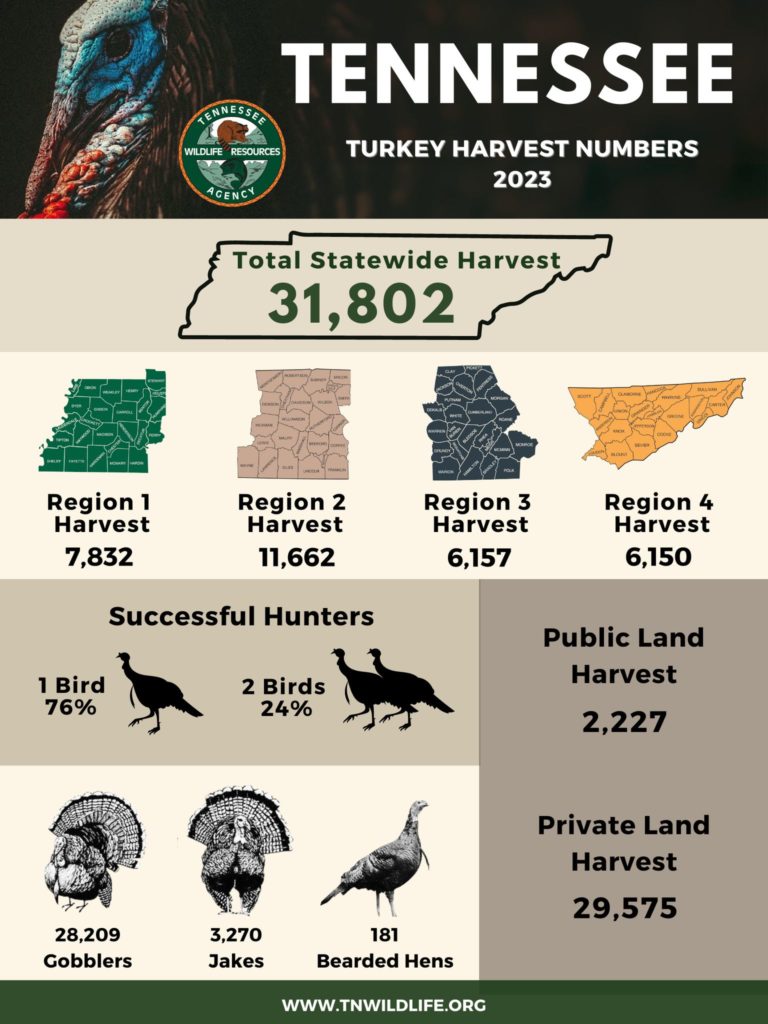
During Tennessee’s 2023 spring turkey season, hunters reported harvesting 31,802 turkeys. This marks a notable six percent increase from the previous year, but a modest two percent decrease from the five-year average of 32,495.
The season brought about changes, including a two-week delay in the opening date and a reduction in the bag limit from three birds to two, with only one allowed to be a juvenile or jake.
The initial days of the season saw a significant spike in the harvest, particularly during the two-day Young Sportsman Hunt and the opening weekend, where reported harvests exceeded the five-year averages by 71 percent and 45 percent, respectively.
However, as the season progressed, there was a sharp decline in the harvest. By the 20-day mark, the reported harvest was only 11 percent above the five-year average.
Roger Shields, TWRA Wild Turkey Program Coordinator, suggests that this decline may be attributed to the lower bag limit, as hunters reached their two-bird limit and had to cease hunting.
This differs from previous seasons when hunters could continue and harvest additional birds. Despite the drop-off, a total of 25,500 hunters reported successfully harvesting at least one turkey, a significant 20 percent increase compared to the five-year average.
In terms of regional breakdown, Middle Tennessee (TWRA Region II) emerged as the leader with 11,662 turkeys harvested, featuring four of the top five counties. West Tennessee (Region I) reported 7,832 turkeys, followed by the Upper Cumberland (Region III) with 6,157, and East Tennessee (Region IV) with 6,150.
Best Counties to Kill a Turkey
Twelve Tennessee counties reported over 500 turkeys harvested during the 2022 spring turkey season. Ten of the twelve are in the central portion of the state, including:
| County | 2022 Spring Turkey Harvest |
|---|---|
| Maury | 1,087 |
| Dickson | 784 |
| Rutherford | 711 |
| Wilson | 697 |
| Montgomery | 669 |
| Marshall | 625 |
| Robertson | 618 |
| Sumner | 548 |
| Williamson | 515 |
| Giles | 501 |
One county in the far northwest corner of the state had a harvest of over 500 birds, and that was Weakley County with 557.
In the eastern part of Tennessee, Green County easily topped the 500 bird mark with a harvest of 840.
It’s worth noting that a higher harvest doesn’t always mean a county offers better turkey hunting than one with a lower harvest. You also have to consider the hunting pressure of each to truly understand the quality of hunting.
Best Public Lands to Kill a Turkey
Tennessee hunters are blessed with over 2 million acres of public hunting lands in the form of wildlife management areas (WMAs), national forests, national wildlife refuges, national recreational areas, and public hunting areas (PHAs). Some of these areas operate on a quota hunt system and require an application and draw process to hunt, but many are open to anyone who purchases the proper permits.
Below is a table breaking down the 2022 spring turkey harvest on each tract of public land. As I mentioned with the county harvests above, just because a tract of public land has a higher number of turkeys harvested, doesn’t mean the turkey hunting is better than one with a lower harvest. You have to consider the size of the property and the number of hunters utilizing the property. But this table will at least give you an idea of which Tennessee public lands have huntable numbers of turkeys.
WMA| Total Harvest | Adult | Juvenile | Unknown |
|
|---|---|---|---|---|
| A.E.D.C. WMA | 91 | 67 | 23 | 1 |
| Arnold Hollow WMA | 6 | 5 | 1 | 0 |
| Bark Camp Barrens | 17 | 12 | 5 | 0 |
| Barkley WMA | 10 | 8 | 2 | 0 |
| Battle Creek PHA | 3 | 2 | 1 | 0 |
| Bean Switch Refuge | 6 | 5 | 1 | 0 |
| Bear Hollow Mountain WMA | 18 | 16 | 2 | 0 |
| Beason Creek | 1 | 0 | 1 | 0 |
| Beaver Dam Creek WMA | 6 | 4 | 2 | 0 |
| Beech River | 3 | 2 | 1 | 0 |
| Big Sandy WMA | 6 | 3 | 3 | 0 |
| Big South Fork | 51 | 46 | 5 | 0 |
| Big Spring Access PHA | 1 | 1 | 0 | 0 |
| Blackburn Fork | 3 | 3 | 0 | 0 |
| Bogota WMA | 9 | 5 | 4 | 0 |
| Bridgestone Firestone WMA – Big Bottom Unit | 9 | 8 | 0 | 1 |
| Bridgestone/Firestone WMA | 11 | 9 | 2 | 0 |
| Browntown WMA | 3 | 3 | 0 | 0 |
| Buffalo Springs WMA | 2 | 2 | 0 | 0 |
| C. M. Gooch WMA | 5 | 4 | 1 | 0 |
| Camden WMA | 10 | 10 | 0 | 0 |
| Catoosa WMA | 60 | 46 | 13 | 1 |
| Cedar Hill Swamp | 1 | 1 | 0 | 0 |
| Charlotte Anne Finnell Neal WMA | 2 | 1 | 1 | 0 |
| Cheatham Lake WMA | 20 | 15 | 5 | 0 |
| Cheatham WMA | 68 | 50 | 17 | 1 |
| Chickamauga WMA | 36 | 31 | 5 | 0 |
| Chickasaw NWR | 24 | 22 | 2 | 0 |
| Chickasaw SF & WMA | 22 | 16 | 6 | 0 |
| Chuck Swan WMA & SF | 32 | 24 | 8 | 0 |
| Colonel Forrest V. Durand | 1 | 1 | 0 | 0 |
| Cordell Hull Wildlife Refuge | 19 | 15 | 3 | 1 |
| Cordell Hull WMA | 24 | 21 | 3 | 0 |
| Cove Creek WMA | 11 | 9 | 2 | 0 |
| Cross Creeks NWR | 22 | 15 | 7 | 0 |
| Dry Creek WMA | 9 | 8 | 1 | 0 |
| Eagle Creek WMA | 27 | 19 | 8 | 0 |
| Eagle Lake Waterfowl Refuge | 1 | 1 | 0 | 0 |
| Edgar Evins SP & WMA | 24 | 17 | 7 | 0 |
| Ernest Rice WMA | 2 | 2 | 0 | 0 |
| Fall Creek Falls SP | 1 | 1 | 0 | 0 |
| Flintville WMA | 3 | 3 | 0 | 0 |
| Foothills WMA | 4 | 2 | 2 | 0 |
| Forks of the River WMA | 2 | 1 | 1 | 0 |
| FT Campbell | 2 | 1 | 1 | 0 |
| Haley-Jaqueth WMA | 5 | 5 | 0 | 0 |
| Hampton Crossroads PHA | 1 | 1 | 0 | 0 |
| Happy Hollow | 2 | 1 | 1 | 0 |
| Harmon Creek WMA | 7 | 6 | 1 | 0 |
| Harp | 3 | 2 | 1 | 0 |
| Hart’s Mill | 6 | 5 | 1 | 0 |
| Hatchie NWR | 5 | 4 | 1 | 0 |
| Haynes Bottom WMA | 7 | 5 | 1 | 1 |
| Headwaters | 3 | 3 | 0 | 0 |
| Henderson Island Refuge | 5 | 5 | 0 | 0 |
| Henderson Swamp PHA | 3 | 3 | 0 | 0 |
| Hick Hill WMA | 15 | 9 | 6 | 0 |
| Hickory Flats WMA | 2 | 2 | 0 | 0 |
| Hiwassee Wildlife Refuge | 22 | 15 | 7 | 0 |
| Holston AAP | 6 | 5 | 1 | 0 |
| Horns Bluff Waterfowl Refuge | 3 | 1 | 2 | 0 |
| Jarrell Switch Waterfowl | 1 | 1 | 0 | 0 |
| John Tully WMA | 11 | 9 | 2 | 0 |
| Keyes-Harrison WMA | 3 | 2 | 1 | 0 |
| Kingston Wildlife Refuge | 1 | 1 | 0 | 0 |
| Kyker Bottoms WMA | 1 | 1 | 0 | 0 |
| Kyles Ford WMA | 1 | 1 | 0 | 0 |
| Land Between The Lakes WMA | 30 | 29 | 1 | 0 |
| Laurel Hill WMA | 9 | 4 | 5 | 0 |
| Lick Creek Bottoms WMA | 15 | 5 | 10 | 0 |
| Lower Hatchie NWR | 9 | 8 | 1 | 0 |
| Luper Mountain | 2 | 2 | 0 | 0 |
| Maness Swamp Refuge | 4 | 2 | 2 | 0 |
| Meeman-Shelby Forest State Park and Natural Area | 5 | 4 | 1 | 0 |
| Mingo Swamp | 1 | 1 | 0 | 0 |
| Moss Island WMA | 4 | 4 | 0 | 0 |
| Mt. Roosevelt WMA | 7 | 6 | 1 | 0 |
| MTSU WMA | 5 | 4 | 0 | 1 |
| Natchez Trace SF & WMA | 64 | 42 | 21 | 1 |
| Nolichucky WMA | 9 | 4 | 5 | 0 |
| Normandy WMA | 10 | 8 | 2 | 0 |
| North Cherokee NF & WMA | 119 | 93 | 23 | 3 |
| North Chickamauga Creek WMA | 8 | 5 | 3 | 0 |
| North Chickamauga Creek WMA - Patton Unit | 1 | 1 | 0 | 0 |
| North Cumberland WMA | 189 | 167 | 21 | 1 |
| Oak Ridge WMA | 4 | 4 | 0 | 0 |
| Obed Wild and Scenic River | 3 | 1 | 2 | 0 |
| Obion River WMA | 21 | 20 | 1 | 0 |
| Old Hickory Lock 5 Refuge | 3 | 1 | 1 | 1 |
| Old Hickory WMA | 60 | 40 | 20 | 0 |
| Owl Hollow WMA | 16 | 12 | 4 | 0 |
| Paint Rock Refuge | 1 | 1 | 0 | 0 |
| Parker Branch | 2 | 2 | 0 | 0 |
| Pea Ridge WMA | 11 | 10 | 0 | 1 |
| Percy Priest WMA | 103 | 83 | 17 | 3 |
| Pickett SF | 15 | 11 | 4 | 0 |
| Prentice Cooper SF & WMA | 36 | 23 | 13 | 0 |
| Rankin Bottom WMA | 5 | 4 | 1 | 0 |
| Reelfoot NWR | 4 | 3 | 1 | 0 |
| Reelfoot WMA | 3 | 3 | 0 | 0 |
| Shady Park PHA | 2 | 1 | 1 | 0 |
| Shelton Ferry WMA | 6 | 3 | 3 | 0 |
| Skinner Mountain WMA | 7 | 7 | 0 | 0 |
| South Cherokee WMA | 127 | 92 | 32 | 3 |
| Standing Stone SF & WMA | 19 | 19 | 0 | 0 |
| Tellico Lake | 62 | 43 | 19 | 0 |
| Tennessee NWR | 26 | 17 | 8 | 1 |
| The Boils WMA | 2 | 2 | 0 | 0 |
| Thorny Cypress | 3 | 2 | 1 | 0 |
| Three Rivers WMA | 3 | 2 | 1 | 0 |
| Tie Camp WMA | 6 | 4 | 1 | 1 |
| Tigrett WMA | 3 | 2 | 1 | 0 |
| Tumbleweed WMA | 19 | 16 | 3 | 0 |
| Watts Bar WMA | 4 | 3 | 1 | 0 |
| West Sandy WMA | 2 | 1 | 1 | 0 |
| White Lake Wildlife Refuge | 5 | 4 | 1 | 0 |
| White Oak WMA | 10 | 10 | 0 | 0 |
| Williamsport WMA | 29 | 19 | 10 | 0 |
| Wolf River and Ghost River SNA Unit 1 | 8 | 6 | 2 | 0 |
| Wolf River and Ghost River SNA Unit 2 | 3 | 3 | 0 | 0 |
| Yanahli WMA | 121 | 82 | 36 | 3 |
| Yuchi Refuge | 6 | 3 | 3 | 0 |
| Grand total | 2199 | 1698 | 476 | 25 |
Keep in mind that calling or attempting to call wild turkeys using any means to mimic the sounds made by turkeys is prohibited on all WMAs from March 1 until the opening day of the spring turkey hunts on the WMA. Fanning or reaping turkeys on WMAs is also prohibited.
Final Thoughts
Despite the regional decline in turkey populations, Tennessee hunters continue to post some excellent harvest numbers. Hopefully, the conservative measures that the TWRA is taking will ensure those opportunities continue well into the future. Here’s to hoping each of you have a fantastic and safe 2023 spring turkey season!

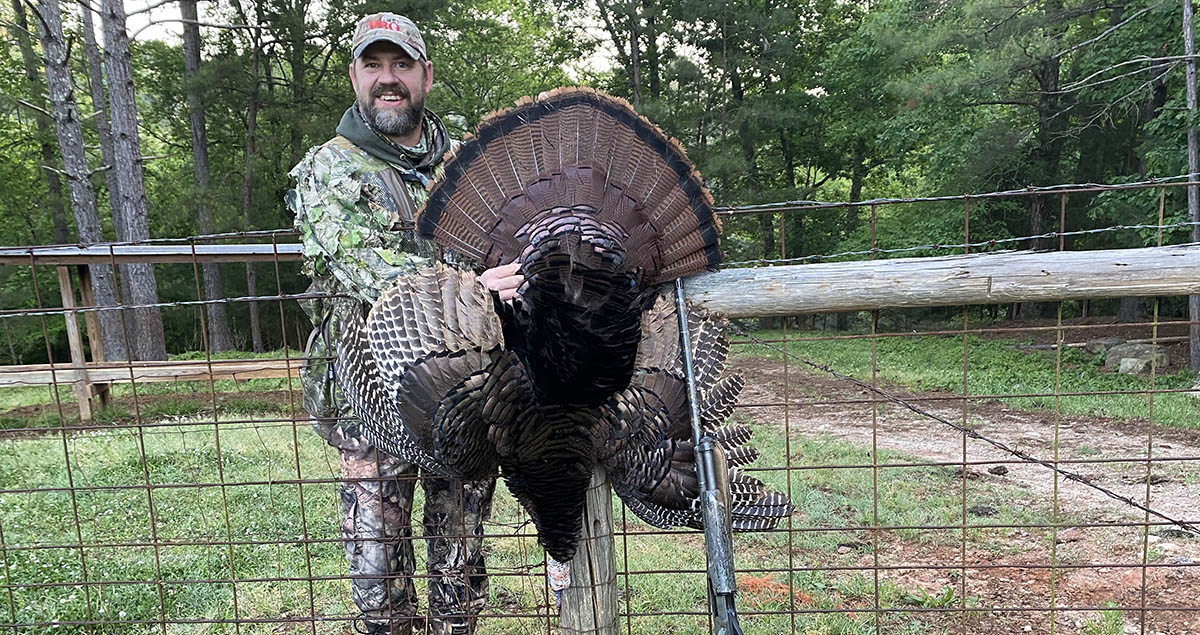
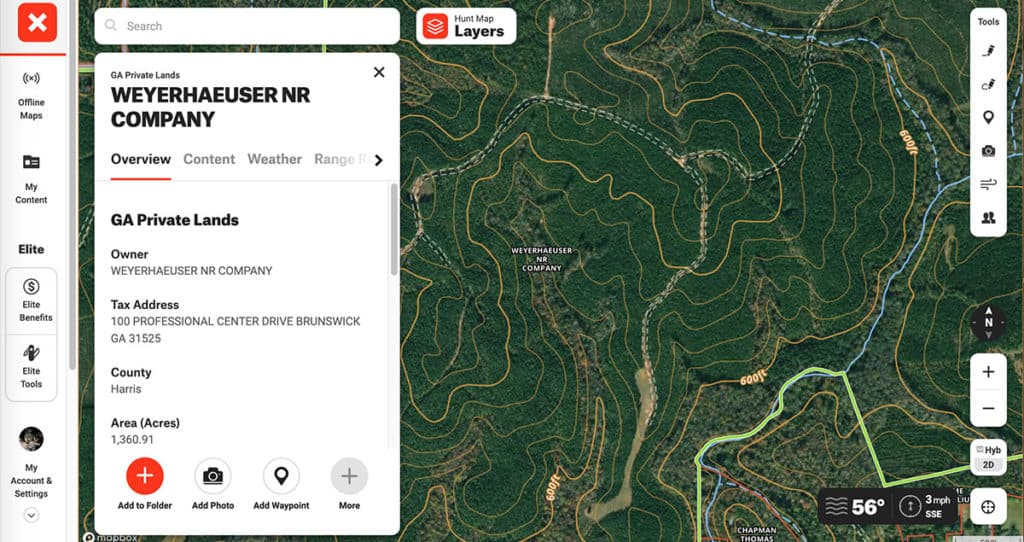
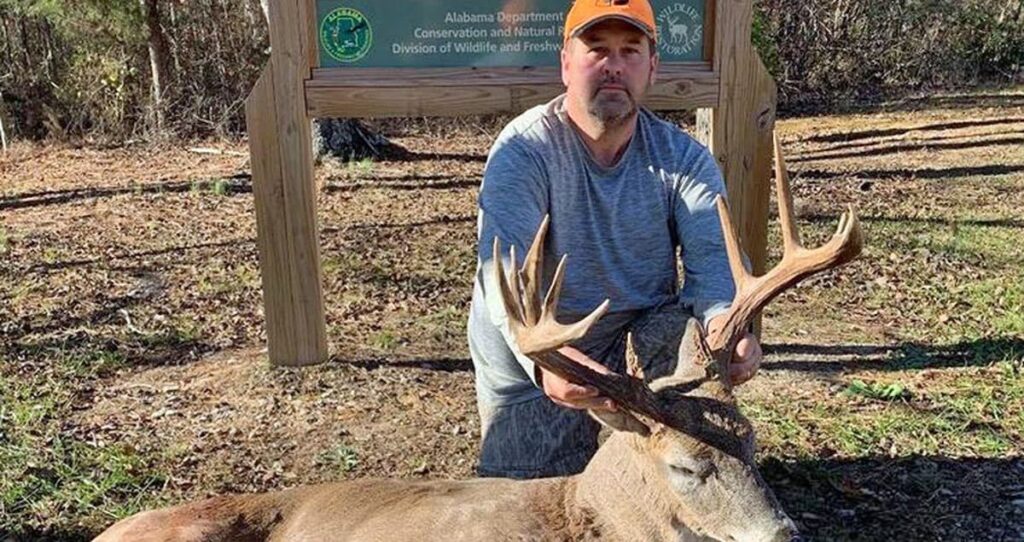
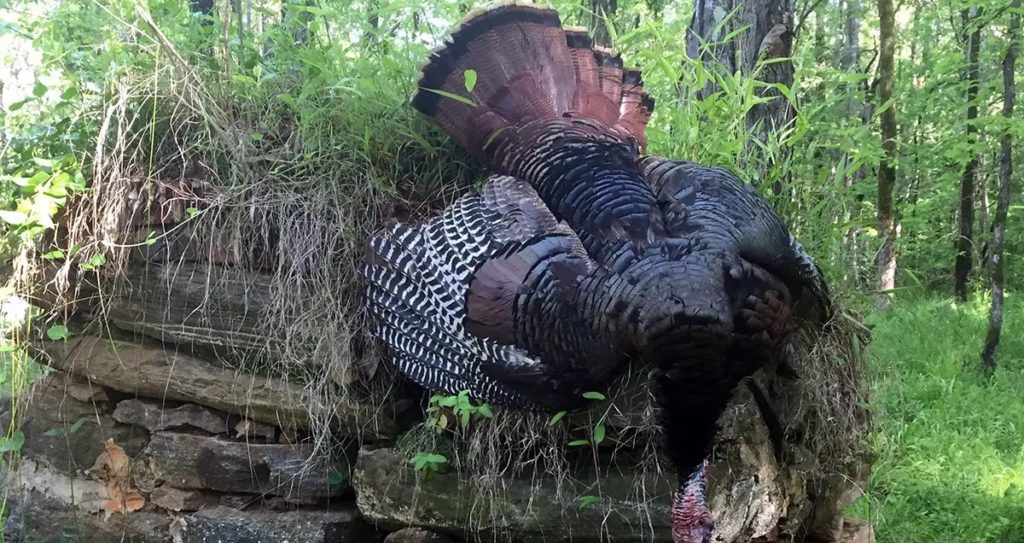
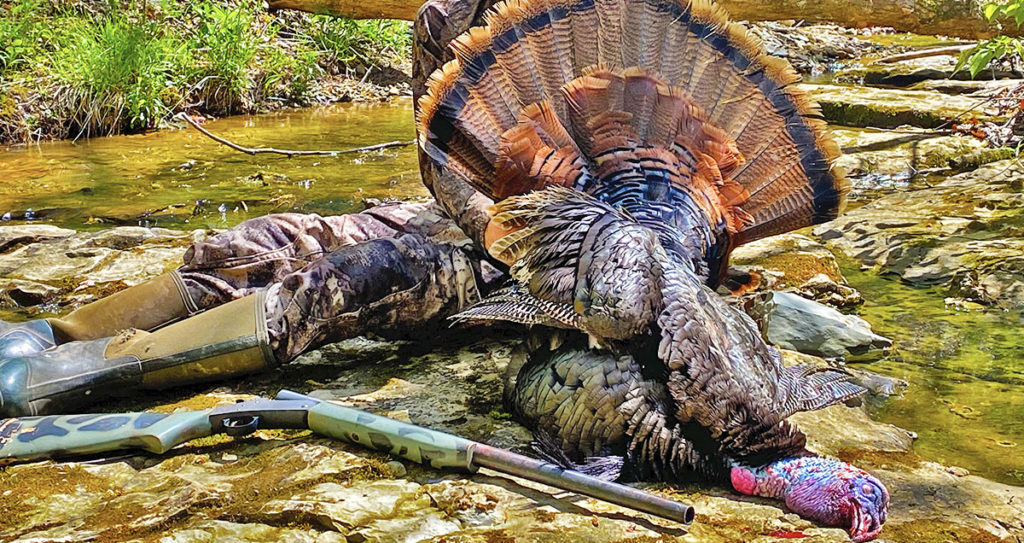

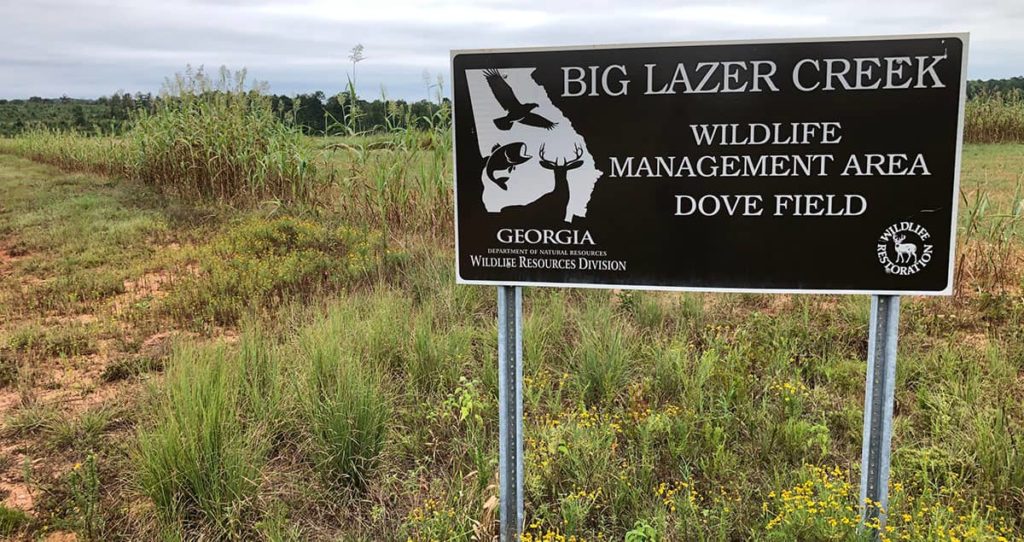
Thank you, interesting facts. Seeing lots of hen activity in the western part of Hickman county. Not seeing a lot of gobblers roaming around in the pastures.